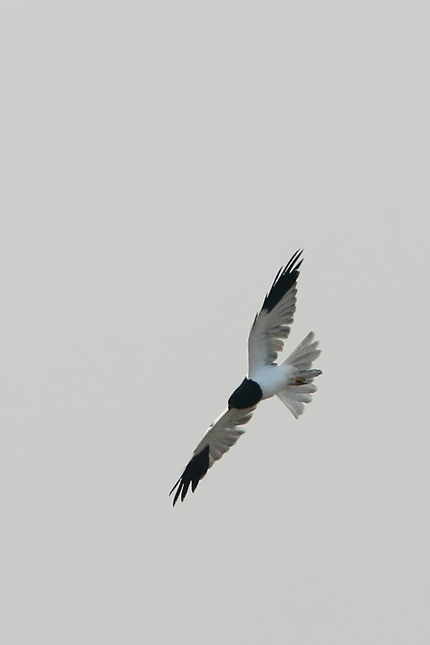m |
(→External Links: GSChecked template added) |
||
| (9 intermediate revisions by 6 users not shown) | |||
| Line 1: | Line 1: | ||
| − | + | [[Image:Pied_Harrier.jpg|thumb|450px|right|Photo © by {{user|AyuwatJ|AyuwatJ}} <br/> Cho Lae, Chiangmai, [[Thailand]]]] | |
| − | [[Image:Pied_Harrier.jpg|thumb| | + | ;[[:Category:Circus|Circus]] melanoleucos |
| − | + | ||
| − | Cho Lae, Chiangmai, Thailand | ||
==Identification== | ==Identification== | ||
| − | + | Adult male - head, nape, ,throat, breast, back, scapulars black, upper tail coverts white with grey barring, yellow eyes, yellow or green cere, feet yellow-orange. | |
| − | |||
| − | |||
| − | |||
| − | + | Adult female - dark brown crown, nape, upper side, tail grey brown with 5 broad brown bands, white underpart, brown eyes, grey cere and yellow legs. | |
| + | ==Distribution== | ||
| + | East and South-East [[Asia]]. | ||
| + | ==Taxonomy== | ||
| + | This is a [[Dictionary_M-S#M|monotypic]] species<sup>[[#References|[1]]]</sup>. | ||
| + | ==Habitat== | ||
| + | Open grasslands, swamps, marshes and paddyfields. | ||
| + | ==Behaviour== | ||
| + | ====Diet==== | ||
| + | Diet includes frogs, lizards, ground birds and insects. | ||
| + | ====Breeding==== | ||
| + | Nests made of grass, reeds and weeds are built on the ground. 4-5 white-green eggs are laid. The female incubates for 30 days and both parents feed the young. | ||
| + | ===Vocalisation==== | ||
| + | In display the male's call is ''keee-veeee'' and the female's a rapid ''kee-kee-kee'', or a rapid chattering ''chak-chak-chak-chak-chak-chak'', rather like the call of a magpie. | ||
| + | ==References== | ||
| + | #{{Ref-Clements6thOct23}} | ||
| + | {{ref}} | ||
==External Links== | ==External Links== | ||
| − | + | {{GSearch|"Circus melanoleucos" {{!}} "Pied Harrier"}} | |
| − | [[Category:Birds]] | + | {{GS-checked}}1 |
| + | <br /> | ||
| + | <br /> | ||
| + | |||
| + | |||
| + | [[Category:Birds]] [[Category:Circus]] | ||
Latest revision as of 21:01, 27 October 2024
- Circus melanoleucos
Identification
Adult male - head, nape, ,throat, breast, back, scapulars black, upper tail coverts white with grey barring, yellow eyes, yellow or green cere, feet yellow-orange.
Adult female - dark brown crown, nape, upper side, tail grey brown with 5 broad brown bands, white underpart, brown eyes, grey cere and yellow legs.
Distribution
East and South-East Asia.
Taxonomy
This is a monotypic species[1].
Habitat
Open grasslands, swamps, marshes and paddyfields.
Behaviour
Diet
Diet includes frogs, lizards, ground birds and insects.
Breeding
Nests made of grass, reeds and weeds are built on the ground. 4-5 white-green eggs are laid. The female incubates for 30 days and both parents feed the young.
Vocalisation=
In display the male's call is keee-veeee and the female's a rapid kee-kee-kee, or a rapid chattering chak-chak-chak-chak-chak-chak, rather like the call of a magpie.
References
- Clements, J. F., P. C. Rasmussen, T. S. Schulenberg, M. J. Iliff, T. A. Fredericks, J. A. Gerbracht, D. Lepage, A. Spencer, S. M. Billerman, B. L. Sullivan, and C. L. Wood. 2023. The eBird/Clements checklist of Birds of the World: v2023. Downloaded from https://www.birds.cornell.edu/clementschecklist/download/
Recommended Citation
- BirdForum Opus contributors. (2025) Pied Harrier. In: BirdForum, the forum for wild birds and birding. Retrieved 10 May 2025 from https://www.birdforum.net/opus/Pied_Harrier
External Links
GSearch checked for 2020 platform.1




